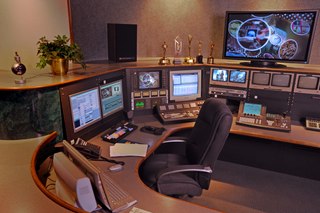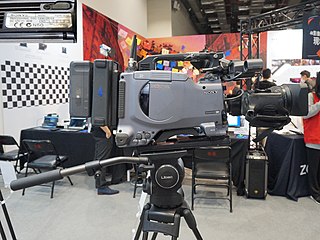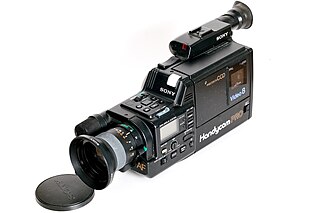Related Research Articles

Non-linear editing is a form of offline editing for audio, video, and image editing. In offline editing, the original content is not modified in the course of editing. In non-linear editing, edits are specified and modified by specialized software. A pointer-based playlist, effectively an edit decision list (EDL), for video and audio, or a directed acyclic graph for still images, is used to keep track of edits. Each time the edited audio, video, or image is rendered, played back, or accessed, it is reconstructed from the original source and the specified editing steps. Although this process is more computationally intensive than directly modifying the original content, changing the edits themselves can be almost instantaneous, and it prevents further generation loss as the audio, video, or image is edited.

Videotape is magnetic tape used for storing video and usually sound in addition. Information stored can be in the form of either an analog or digital signal. Videotape is used in both video tape recorders (VTRs) and, more commonly, videocassette recorders (VCRs) and camcorders. Videotapes have also been used for storing scientific or medical data, such as the data produced by an electrocardiogram.
A hard disk recorder (HDR) is a system that uses a high-capacity hard disk to record digital audio or digital video. Hard disk recording systems represent an alternative to reel-to-reel audio tape recording and video tape recorders, and provide non-linear editing capabilities unavailable using tape recorders. Audio HDR systems, which can be standalone or computer-based, are typically combined with provisions for digital mixing and processing of the audio signal to produce a digital audio workstation (DAW).

A camcorder is a self-contained portable electronic device with video and recording as its primary function. It is typically equipped with an articulating screen mounted on the left side, a belt to facilitate holding on the right side, hot-swappable battery facing towards the user, hot-swappable recording media, and an internally contained quiet optical zoom lens.
A digital video recorder (DVR) is an electronic device that records video in a digital format to a disk drive, USB flash drive, SD memory card, SSD or other local or networked mass storage device. The term includes set-top boxes (STB) with direct to disk recording, portable media players and TV gateways with recording capability, and digital camcorders. Personal computers are often connected to video capture devices and used as DVRs; in such cases the application software used to record video is an integral part of the DVR. Many DVRs are classified as consumer electronic devices; such devices may alternatively be referred to as personal video recorders (PVRs), particularly in Canada. Similar small devices with built-in displays and SSD support may be used for professional film or video production, as these recorders often do not have the limitations that built-in recorders in cameras have, offering wider codec support, the removal of recording time limitations and higher bitrates.

Pro Tools is a digital audio workstation (DAW) developed and released by Avid Technology for Microsoft Windows and macOS. It is used for music creation and production, sound for picture and, more generally, sound recording, editing, and mastering processes.
CamCutter is a digital video camera technology developed by Ikegami and Avid Technology for recording broadcast quality video to hard disk, dubbed a Digital Disk Recorder. First revealed in 1995 at the National Association of Broadcasters convention in Las Vegas, it used a camera mechanism by Ikegami and a special FieldPack unit instead of a tape transport unit. The CamCutter outpaced subsequent tapeless camcorders introduced by Sony and Panasonic by years. In October 2010, the National Academy of Television Arts & Sciences (NATAS) announced the recipients of the 62nd Annual Technology & Engineering Emmy® Awards. Ikegami and Avid Technology were announced as a winner for the Development and Production of Portable Tapeless Acquisition. Today's CamCutter technology can be found in Ikegami's Editcam products.

HDV is a format for recording of high-definition video on DV videocassette tape. The format was originally developed by JVC and supported by Sony, Canon, and Sharp. The four companies formed the HDV Consortium in September 2003.

XDCAM is a series of products for digital recording using random access solid-state memory media, introduced by Sony in 2003. Four different product lines – the XDCAM SD, XDCAM HD, XDCAM EX and XDCAM HD422 – differ in types of encoder used, frame size, container type and in recording media.

P2 is a professional digital recording solid-state memory storage media format introduced by Panasonic in 2004. The P2 card is essentially a RAID of Secure Digital (SD) memory cards with an LSI controller tightly packaged in a die-cast PC Card enclosure. The system includes cameras, decks as drop-in replacements for videotape decks, and a special 5.25-inch computer drive for random-access integration with non-linear editing systems (NLE). The cards can also be used directly where a PC card (PCMCIA) slot is available, as in most older notebook computers, as a normal hard disk drive, although a custom software driver must first be loaded.

Digital cinematography is the process of capturing (recording) a motion picture using digital image sensors rather than through film stock. As digital technology has improved in recent years, this practice has become dominant. Since the mid-2010s, most movies across the world are captured as well as distributed digitally.
Avid DNxHD is a lossy high-definition video post-production codec developed by Avid for multi-generation compositing with reduced storage and bandwidth requirements. It is an implementation of SMPTE VC-3 standard.

Avid Media Composer is a video editing application or non-linear editing system (NLE) developed by Avid Technology. It was initially released in 1989 as an offline editing system on the Macintosh II. Since the 1990s, Media Composer has been the dominant non-linear editing system in the high-end film and television industry, allowing offline and online editing workflows, including up to 16K editing and finishing. Much of its design, implementation, and terminology is derived from the people and practices found in filmmaking and broadcast.
AVCHD is a file-based format for the digital recording and playback of high-definition video. It is H.264 and Dolby AC-3 packaged into the MPEG transport stream, with a set of constraints designed around the camcorders.

Sony Corporation produces professional, consumer, and prosumer camcorders such as studio and broadcast, digital cinema cameras, camcorders, pan-tilt-zoom and remote cameras.

The Archos AV series is a line of portable media players from the company called Archos that was released through 2003 to 2005. This series introduced the digital video recorder for the AV500, an optional feature that would be compatible in subsequent players. Although the AV series did not have standalone digital audio players, Archos did release them under the concurrently released Gmini series.
Ingex is an open-source (GPL) suite of software for the digital capture of audio and video data, without the need for traditional audio or video tape or cassettes. Serial digital interface (SDI) capture is supported, as well as real-time transcoding. Portions of the software suite also act as a network file server for media files, as well as archiving to LTO-3 data tape. Audio and video media files can also be stored on USB hard drives or Network Attached Storage. The software is heavily used by the BBC, and was developed by the BBC Research Laboratory.
The French consumer electronics company Archos manufactured a number of products which have since been discontinued.
Apple ProRes is a high quality, "visually lossless" lossy video compression format developed by Apple Inc. for use in post-production that supports video resolution up to 8K. It is the successor of the Apple Intermediate Codec and was introduced in 2007 with Final Cut Studio 2. Much like the H.26x and MPEG standards, the ProRes family of codecs use compression algorithms based on the discrete cosine transform (DCT). ProRes is widely used as a final format delivery method for HD broadcast files in commercials, features, Blu-ray and streaming.
References
- ↑ Torelli, Joe (2010). Apple Pro Training Series: Final Cut Pro for News and Sports Quick-Reference Guide, 2nd edition . Berkeley, CA: Peachpit Press. p. 49. ISBN 9780321564061.
- ↑ Jones, Graham; Layer, David; Osenkowsky, Thomas (2013). National Association of Broadcasters Engineering Handbook. Burlington, MA: Taylor & Francis. p. 1129. ISBN 9780240807515.
- ↑ Fox, Christina (Oct 2000). "Ikegami's Editcam Disk Camera". urbanfox.tv. Retrieved 2023-03-15.
- 1 2 Browne, Steven (2014). High Definition Postproduction: Editing and Delivering HD Video . Burlington, MA: Focal Press. p. 112. ISBN 9780240808390.